The Best Fishing Line For Trout in 2024: What Guides Use
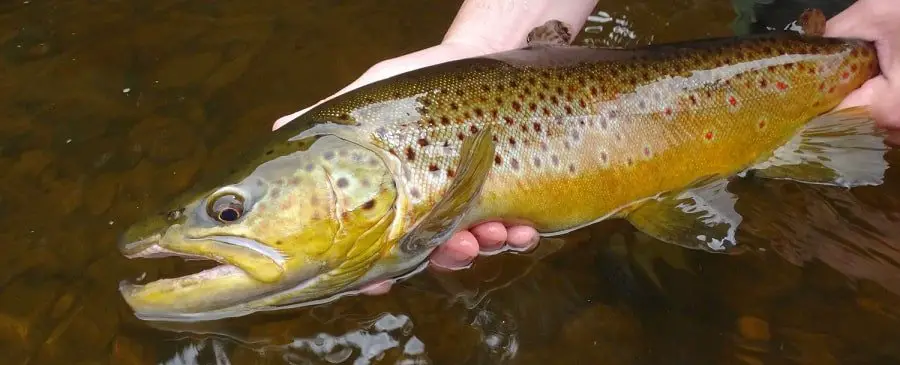
I will discuss the best fishing line for trout fishing and why I and other trout guides only use premium fishing lines. I will also discuss the best sizes and types of fishing lines for different methods, and when fishing trout in rivers and lakes.
My Quick Pick Best Fishing Lines:
- Sufix Elite – Best Monofilament: This is the best monofilament line for lures and bait fishing for trout fishing on small streams and ponds, I use 6-pound. For bigger lakes, fast rivers, or large trout, upsize to 8-pound line.
- Raven Mainline – Best For Float Fishing: The best line for float fishing is the Raven Mainline because it is more buoyant and lightweight when compared to other lines.
- Sufix 832 – Best All-Purpose Trout Line: Braided line like the Sufix 832 is great for casting lures and for bait fishing as long as you use a fluorocarbon leader. Many anglers prefer it over mono.
- Seaguar Tatsu – Best Fluorocarbon: The Seaguar TATSU Spinning Line is my favorite fluorocarbon line for spinning reels, and I use it only for lures and drift fishing.
These are the lines I use the most. They all have pros and cons which you should consider, and you should know which lines are best for different methods.
We may make a small commission from some of the links on this website, which is at no cost to you. I appreciate your support. Learn More
The 3 Best Trout Lines
The three best trout lines are Monofilament, Fluorocarbon, and Braided lines, and each one has advantages and disadvantages depending on the type of water you are fishing and the type of method that you are using.
- Braided Line: I use it a lot on the fishing reels that I use for casting lures in lakes or rivers. I will also use this for float fishing. I like to use braided lines for a number of reasons, which I will discuss below.
- Fluorocarbon Line: Many skilled anglers and guides will prefer a quality fluorocarbon line when casting lures in rivers or when using methods like Drift Fishing or bottom bouncing.
- Monofilament Line: The most popular line due to price and because it’s been around longer than other types of line. It’s still a good all-purpose line. I mostly use it when I am float fishing for trout in rivers, I only use premium monofilament lines and avoid the cheap stuff.
Is Mono The Best Line For Trout Fishing?
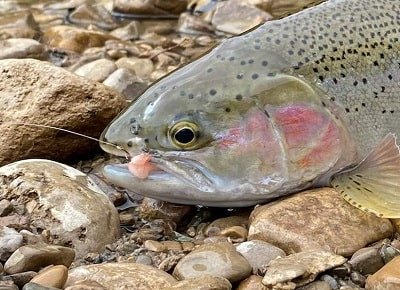
The monofilament line is the most used fishing line by trout anglers. Mono is the most used line because the monofilament line works well with most methods used for trout fishing, making it the most versatile and easy to use.
When I use a mono line for trout fishing with both bait and lures, I find that it always works best with a good fluorocarbon leader setup.
The major benefits of mono are:
- It is sold everywhere
- It works well on all reels
- It works well with all trout fishing methods
- It also comes in many colors (see below which is best)
- It comes in all the needed sizes for fishing trout
- It’s the least expensive of all the fishing lines
The Best Monofilament Lines For Trout Fishing
You must use a good monofilament line for trout fishing if you want to be able to fish well with mono.
The best monofilament lines for trout fishing are premium lines or what I call performance lines, and I will discuss the advantages of these lines and the disadvantages of the cheap lines.
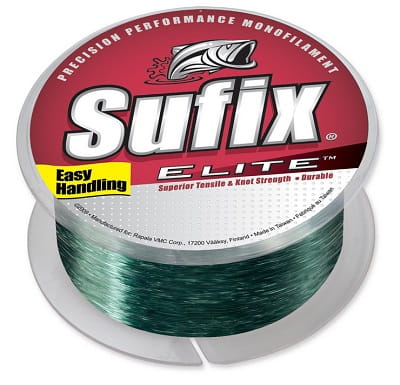
Sufix Elite
This is my favorite all-around mono line for trout and steelhead fishing with spinning reels.
I know many river anglers and other guides who also really like this line.
The key features are
- Superior strength, handling, and durability
- J7 Micro Resin process
- Slick line for farther casts
- Exclusive G2 precision winding
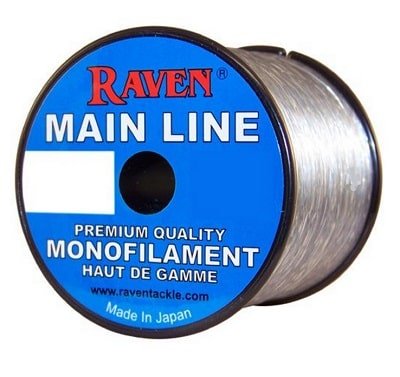
Raven Main Line
This is my favorite line when float fishing for trout. I use it on my spinning reels and on my Centerpin reels.
It’s widely used by other trout anglers and by many fishing guides.
Key Features Are:
- Excellent abrasion resistance
- High breaking strength
- High buoyancy
- Good for float fishing.
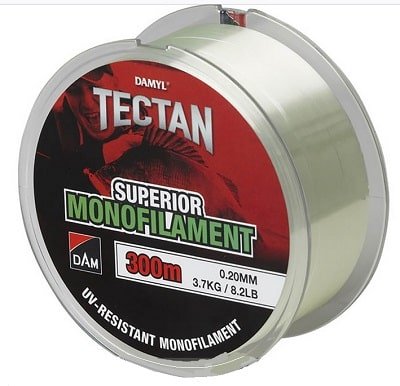
DAM Damyl Tectan
A well-rated line that is very supple with a UV coating to make it last longer.
This is a great line for trout fishing in rivers but is also well-liked by lake anglers.
- UV-protective surface treatment
- Low visibility
- Low memorySuperior abrasion-resistant
- Parallel winding
- Medium elongation
Line Sizing
Before you go out and buy a fishing line, check out my line sizing table for reference. These are the line sizes U use.
| Species and Size Class | Flourocarbon/Leader | Braided Line | Monofilament | Flourocarbon Mainline |
|---|---|---|---|---|
| Brook trout: 8-20 inches | 2-4 lb test | 8-15 lb test | 6-10 lb test | 6-10 lb test |
| Rainbow trout: 8-20 inches | 2-4 lb test | 8-15 lb test | 6-10 lb test | 6-10 lb test |
| Brown trout: 15-30 inches | 2-8 lb test | 8-15 lb test | 8-15 lb test | 8-15 lb test |
| Steelhead: 20-30 inches | 8-10 lb test | 15-30 lb test | 10-15 lb test | 8-15 lb test |
| Salmon: 20-50 inches | 10-20 lb test | 20-30 lb test | 15-20 lb test | 15-20 lb test |
| Lure Fishing | 8-10 lb test | 15-30 lb test | 10-15 lb test | 8-15 lb test |
The Best Fluorocarbon Fishing Line For Trout
Fluorocarbon lines are arguably the best fishing lines for trout in rivers and lakes when using certain methods. Fluorocarbon has its advantages and disadvantages, but the important thing with fluorocarbon is to buy the right one.
Cheap fluorocarbon lines cause many problems and give fluorocarbon a bad name, but it doesn’t need to be that way.
The primary advantages of the fluorocarbon line are that it is the most invisible fishing line to the fish and it’s very abrasion-resistant, which can be great if you are fishing around a lot of rocks or logs. It also tends to sink and has less stretch than monofilament, making it the best fishing line for trout.
Since the fluorocarbon line tends to sink, it is good when fishing with lures, but I avoid it and do not recommend it when float fishing because it sinks and causes problems.
Best Fluorocarbon
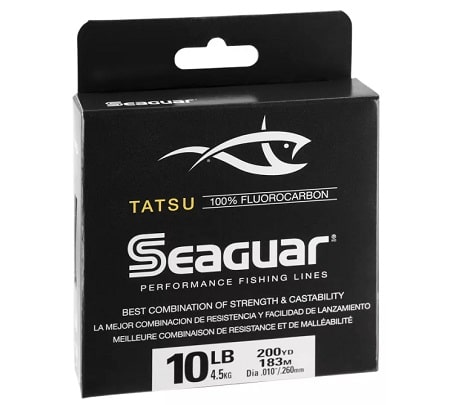
One of the best fluorocarbon lines for baitcasting reels is Seaguar Tatsu Fluorocarbon Line.
The Seaguar company is well known for having the best quality fluorocarbon lines in the world, and they are always a good choice.
The best fluorocarbon lines for spinning reels when fishing for trout are:
- Seaguar Inviz-X fluorocarbon line is one that I have used for many years and is often my go-to line for leaders and for casting lures. This might be the highest-rated fluorocarbon line in the world.
- P-Line Fluorocarbon 100 % Pure Line – The P-line Fluorocarbon is a good line used by trout anglers, and it is one of the highest-rated lines available.
Braided Fishing Line For Trout
I have also used braided lines when float fishing with spinning reels, baitcasting reels, and even Centerpin reels, but you must use a good leader setup and know how to secure it to the reel properly so it doesn’t slip on the spool.
The Best Braid For Trout
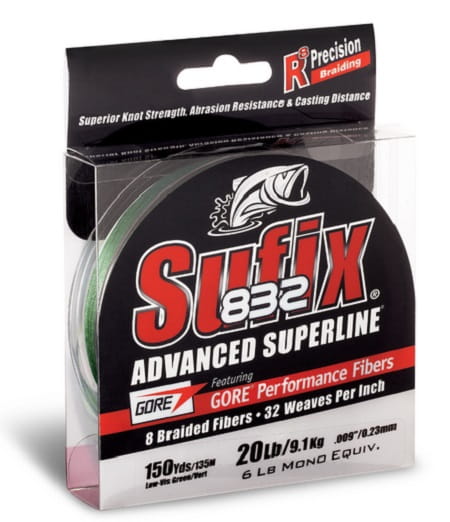
I use braided lines like Sufix 832, Power Pro, SpiderWire, or Fireline on my reels, which I only use for casting lures in lakes and rivers.
My new favorite braided line is Sufix 832 in the dark green color, but before that, I had been using Powerpro since around 2006.
Expert lure anglers and guides know that when fishing for trout in a river or lake with jagged rocks or with lots of wood and sunken trees, you want to use fluorocarbon and not braid because the braid will cut into the wood, and you’ll get hung up. The sharper rocks can also cut through the braid.
The advantages to using braid when float fishing or bottom bouncing are:
- There is no stretch, so long hooksets are better.
- Most braided lines float, which is excellent when float fishing.
- The braided line has very low or no memory.
- Braided lines come off the spool smoothly.
- Braided lines are extra strong for their diameter.
- Braided lines are more sensitive to help you detect strikes when you are bottom-bouncing.
The disadvantages of braided lines when float fishing:
- You need a fluorocarbon leader or the trout will see the line.
- Because there is no stretch, it is more common to break fish off on the hookset or when fishing with a leader.
- Braid is not as easy to tie knots with, and you will need special knots for the braid, such as the Palomar or double Uni Knot.
- The float caps that hold the float to the line can break more often with a thin braided line.
- Braided line can freeze in the winter because it can absorb water and freeze, and even the entire spool can freeze solid if you dunk your reel into the water in below-freezing temperatures.
- Not properly securing a braided line to a reel can cause the entire line to spin freely around the spool, making it impossible to reel in. This can occur if you tie the braid directly to the spool without a mono backing or taping it to the spool.
Sufix Nanobraid Line
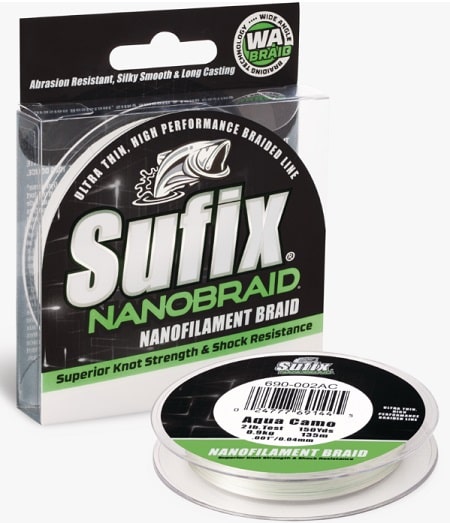
Sufix Nanobraid fishing line is a good option for trout fishing with lures. It is super strong, thin, and is silky smooth for long casts.
Best Fishing Line For Trout FAQ
I hope this article on the best fishing line for trout was helpful. The full extended version, which can be seen at https://troutandsteelhead.net/trout-lines-extended-article/ covers a lot more and answers the many questions angler shave, such as:
- Is Copolymer Line Good For Trout Fishing?
- Does Line Color Matter?
- What Is The Best Line For Trolling For Trout?
- What Is The Best Fishing Line For Trout In Dirty Water?
- What Is The Best Fishing Line For Trout In Clear Water?
- What Is The Best Fishing Line For Trout In Rivers?
- What Is The Best Line For Centerpin Reels?
- Best Lines For Different Types Of Reels
- Leaders – Do You Need Them?
- What Pound Test For Trout In Lakes?
- How To Straighten Fishing Line?
- What Pound Line For Trout in Rivers?
If you have any comments, tips, or questions, let me know in the comments section below.
Tight Lines,
Graham

I was not able to see your mono to flourocarbon line set up. Please let me know the lenght for leader tied on the mono line. Thanks.
Hey Shayne,
I have just revised the article and added more info including a section on using leaders.
To answer your question, I always use a 3 to a 5-foot fluorocarbon leader anytime that I use a colored line, braid, or even mono lines, and that goes for almost any method that I use when fishing for trout in a river.
How does this work? Does the knot not get caught on the line guides when casting? This is my main concern when using a leader for trout. I would primarily be casting lures
Hi Logan,
For leaders for lures, a 12 to 24-inch piece of fluorocarbon leader attached to the mainline using a knot like a Uni-Uni knot is what I use. You should be able to reel the knot into the guides and cast without any issues or sticking, however, I tend to leave the knot out of the guides most of the time, which is not that hard to do with 16 to 24 inches of leader.
Good Luck,
Graham
Excellent article – thanks for your time and advice.
I’m a salt water fisherman , but getting back into trout fishing after 50 yrs ( retirement!); articles such as this are invaluable!
Nice sir, you have briefly explained. thanks, I got a lot of knowledge about fishing line
Thanks for the great info – the leader concept is new to me and I was wondering, does the knot where you join the leader to the main line get caught in the eyelets of the rod when you cast? Do you need to leave the entire leader line hanging when you cast? Thanks
Hi Charlie,
If you are referring to the leader I use when casting lures or jigging, usually the knot will not stick too bad in the rod guides, and how much it sticks will depend on the type of knot that you use. A knot like a Double Uni Knot or a blood knot is fairly thin and won’t catch as much as some other knots. I also do try to keep my knot out of the rod guides as much as possible when I’m casting. Often this is not a problem with a 2 to 4-foot leader.
Good luck,
Graham
I lake fish from the shore and use 6lb. P-Line – Halo. I use the slip sinker method with floating Glitter Powerbait by Berkley. 1st thing on the line is the slip sinker then a swivel. I use the same line for my leader which will change in length during the day due to water temp changes. Anywhere from 1ft – 3 ft leader, then a treble hook cause it holds the Powerbait the best. Berkley Glitter Powerbait Tequila Sunrise is my personal favorite. It has a couple of fake worms on the bottom of the Powerbait, like real Mexican Tequila!! Hilarious!! I hope this helps. Good fishing to you!!
Great article, Graham.
I have another question on the leader setup. I’m using the monofilament line, and want to incorporate a fluorocarbon leader, as you’ve suggested.
Question: Would a 2mm tippet ring work well, or do you believe that a knot is preferable?
Thanks,
Austin
Tippet rings are another great option for connecting two lines together, I use them and I know a lot of guides that use them.
Graham
Hi Graham
Do you think that trout can see hi viz line abound water to the float ?
I ussualy splice in mono about 2 ft from the float so my line going into the water is clear
Thanks
Joel
Hey Joel,
Yes and No..
No.. because, if you are float fishing, generally you are fishing fairly deep, 3 feet plus depths, and if the line is above the float and out of the water and they are deep, it’s not likely they will see the line and get spooked by it since they are not intelligent enough to know what it is or see it as a danger, they are more likely to see and be spooked by the float, or by your presence.
And Yes… If the fish are feeding high, they will likely see the line, however, if you are float fishing, you are not targeting those fish anyways. If they are feeding high you should consider a different method like advanced bottom bouncing with a high presentation.
The reason I use a shot line all the time is so the mainline, hi-viz or not, is very high in the water column and is far enough away that they don’t see it. If you are still concerned about fish seeing the line you can add your section of extra clear leader line.
Hope that helps.
Graham
For distance casting for stocked trout in lake setting from the shore with slip float , is it better to use braid thru float then flouro leader or go with straight mono or flouro?
Hey Omar,
Braid, due to its very thin diameter, should cast further than mono or fluorocarbon.
The only thing with braid is that the float stops tend to slip out of place easier and more often.
Graham
Thanks Graham!
This is great info, and it’s mostly things I’ve learned over the years. But this is well thought out and all in one place. Plus a few tips I hadn’t thought of before. Keep up the good work!
Great read! I really enjoyed it, very well written and gained alot of knowledge from your article 👍.
Grant!
Kelowna BC, Canada 🇨🇦
Thanks and Good Luck.
Hey Shayne,
I will visit Vancouver, Washington this spring and want to get my first steelhead. I’ve learned so much here so far, thanks for that. My question is, what Lb. test should I buy for fishing with spinnerbaits and float. I would order the Sufix 832 in dark green. Thanks and greetings from germany
Hey Denis,
20 pound Sufix 832 will do the job, just be sure you have the proper leader for the methods you are using.
Graham